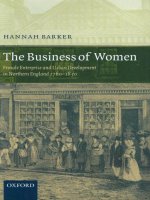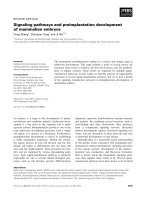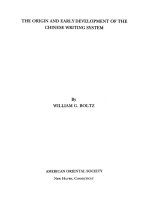The Victorian Era and the Development of the Stoic-Christian Code of Honor
Bạn đang xem bản rút gọn của tài liệu. Xem và tải ngay bản đầy đủ của tài liệu tại đây (267.3 KB, 12 trang )
art ofmanliness.com />Manly Honor: Part III — The Victorian Era and
the Development of the Stoic-Christian Code of
Honor
by Brett & Kate McKay on November 6, 2012 · 42 comments
in A Man's Life, On Manhood
Welcome back to our series on manly honor. Now, I originally planned for the history of honor to
be one post, and then decided I could cover it in two, and now I’m thinking it’s going to take five
posts, counting the one two weeks ago and today’s. Who was I kidding? The topic of manly honor
is both far more complicated and much more fascinating than I had anticipated.
Now brace yourself – today’s post is a doozy. The topic of honor in the Vict orian period is the
most complex part of a complex evolution, as it involves a myriad of influences and factors. The
workload on this one, and t he remaining historical installments, necessitat ed my enlisting of Kate’s
historical research and writing chops, and together we pored through over 1500 pages of
research, and took dozens of pages of notes. After two weeks of banging our heads on our desk,
throwing things, several near mental breakdowns, and one all-nighter, we have completed this
article. All of which is to say, while I pledge my honor that we have done our very best to make
everything as accurate as possible, if there are any errors in our historical facts or terminology, we
welcome your very kind and gentle corrections in the comments. Also welcome are any
encouraging comments. Twil be like manna for the soul.
Okay, let’s get started.
Understanding the Class System in England
At the start of the Victorian era (1830s-1900), English society was highly stratified and hierarchical,
and the population fell into three main classes. The idea of classes is hard for us to fully grasp
from our modern viewpoint. We often t hink of them as having t o do entirely with income level, and
while that was certainly a factor, it also depended on values, education, occupation, family
connections and history, birth, as well as your manners, speech, and clothing.
At the t op of the heap was the landed aristocracy (meaning land ownership was part of their noble
privilege). This “peerage” held titles of nobilit y and largely descended from the warrior nobility of
the Middle Ages who had successfully battled for fiefdoms and then defended those territories
from would-be usurpers. They owned land, but rented it to others to work. Right below the
peerage was the gentry. Because of the system of primogeniture, only the first born sons inherited
a title. Younger sons belonged to the gentry, and though they lacked a title, they were still
considered nobility, and true “gentlemen.” Whether titled or not, one of the defining qualities of the
upper class was that they did not have to work, nor taint themselves with the commonness of
trade to earn a living; their income came wholly from owning and renting out land.
The middle class consisted of those who performed “clean,” salaried work. The most distinguished
of the middle class were clergymen, military officers, lawyers, doctors, and the professors and
headmasters of prestigious schools. Farmers who rented a large piece of land but had others do
most of the physical work for them were considered middle class too. Clerical workers were
included but considered lower on the middle class totem pole. Manufacturers, merchants, and
bankers were some of the newer members of the middle class (more on this below), and as white-
collar work expanded, the new journalists, police officers, and insurance agents joined the ranks as
well.
The working class consist ed of those who did any of the “dirty,” physical work that remained.
For cent uries, people had generally accepted the class system and their place in the hierarchy.
Each class had its own rules, standards, culture, and even terminology. It was considered
unthinkable to ape the class above or below you – you had to follow the rules of your own class.
The middle class had only recently emerged. Prior, there had generally been two classes: those
who owned land were the noble – everybody else, ignoble. As we’ll discuss more in the next post,
there are different types of honor in every class, but the landed aristocracy laid exclusive right to
the term. Commoners were decidedly out side their honor group, and contrary to the system of
honor that had existed in primitive times, they could not earn their way into it through adherence
to the group’s honor code. Instead, honor had now become inheritable – passed down to the
aristocracy’s sons. An aristocrat who displayed bad manners or behavior with members of his own
class could theoretically lose the title of gentleman, but the distinction was largely the product of
birth.
The rise of the middle class during the Victorian period created a social fluidity that would
challenge this system, and necessitate the creation of a new honor culture that transcended all
classes.
The Rise of the Middle Class and the Expansion of Honor
At the beginning of the 19
th
century, the
Industrial Revolution was in full swing. The rise
of indust ry powered sweeping changes in the
technological, sociological, and economic
landscape of the West.
When 18-year-old Queen Victoria ascended
to the British throne in 1837, very few of her
subject s had traveled more than 10 miles from
the rural spot in which they were born, goods
and messages could only travel as f ast as a
horse could carry them, and only half of
English citizens could read and write.
When Victoria died in 1901, the pace and
texture of life had dramatically transf ormed.
80% of English citizens now lived in towns and
cities, and some of their homes were outfitted
with electric lights, had cabinets stocked with
canned foods, and sat on gaslight-dotted
streets. Telegraphs carried messages in a
blink, railroad tracks criss-crossed the land, and luxurious steamships fairly whisked passengers
from England to America in only nine days. A man could now write a letter on his typewriter, get his
portrait taken by the local photographer, have an x-ray, vaccination, or chloroform administered by
his doctor, and shave with a safety razor at home instead of visiting the barber to have his
whiskers trimmed. Education for the young had become compulsory, and literacy soared to nearly
100%.
The most important change of the 19
th
century, however, was the rise of the middle class. The
Industrial Revolution not only created manufacturing work, but a booming expansion in trade and
banking, along with a whole new stratum of white-collar jobs.
While England’s economic center of gravity was shifting away from agricultural and towards
industrial capitalism, and while many of the nascent middle-class were earning incomes greater
than those who owned acreage, the status and political power of the new rich in manufacturing,
business, and finance did not keep pace with their rising contribution to the nation’s wealth. The
aristocracy, a centuries-old honor group that had ever been hostile to incursions from outsiders,
vehemently fought against the relinquishing of their position. But the middle-class would force
them t o give way, not simply by attaining wealth and fighting for a voice in government, but by
creating a new honor code – one that was open to all, regardless of class — a code based on
ethics and virtues that would come to supplant the one based on birth.
What Were the Tenets of the Stoic-Christian Code of Honor?
The code of honor that developed from t he middle-class of the Victorian age was truly an
amalgam of several influences:
Rebellion against t he values of t he arist ocracy. Many f elt that during England’s Regency era
(roughly 1795 to 1837), the upper classes had grown decadent , reveling in flamboyance and
dandyism, and focusing too much attention on appearance and clothes. It seemed, to some
Victorians, to have been a period in which materialism had sapped society’s spirituality – the rich
walked around in fine attire, but were rotten to the core. Victorians reacted against this with a
movement towards sobriety and rectitude.
The middle-class also had disdain for the way the aristocracy held up idleness as a virtue, and
looked down upon those who worked for a living. The rising business class turned that idea on it s
head — arguing that idleness was a vice, while work was a nearly sacred virtue.
Revival in evangelical Christ ianit y. Evangelical Christianity moved away from traditional Calvinist
beliefs in total depravity (humans are essentially rotten sinners) and predestination, and instead
emphasized a person’s free will, and that salvation was open to any who chose to believe and
cultivated an inner faith. At the same time, evangelical Protestants preached that a continued
relationship with God was predicated on living righteously, and that believers should strive for an
individual moral perfection, while also working to purify society, reform corrupt practices, and uplift
the downtrodden.
Nost algia. The Victorians, like the folks of the Renaissance, were at the same time progressive
and forward-looking, and nostalgic – they looked to past societies for inspiration on how t o
improve their own. From the medieval period, they drew from the ideals of chivalry (or at least the
folklore of chivalry that had been passed down). From Ancient Greece, they adopt ed parts of Stoic
philosophy.
Expanding Democracy. For cent uries, the landed nobilit y had constituted a near iron-clad
oligarchy — controlling Parliament, and the culture as well. But during the Vict orian Era, those in
the middle class pushed back against the idea that the right to vote and to hold government office
were reserved for the owners of major acreage. Reform bills during this period expanded the
franchise to millions more men, creating a greater sense of egalitarianism and fostering the idea
that gentilit y, and the title of “gentleman,” could transcend class.
The Rise of the Self-Made Man. As previously mentioned, for centuries people largely accepted
being a member of the class they were born into, and there was almost no chance of moving up
into a higher class – a commoner couldn’t work his way into the arist ocracy no matter how hard he
tried. The shift from agriculture to industry opened the possibility (no matter how long the odds
were in reality) of social mobility, or what the English called “removable inequality.” High status in
society could be earned, but only if a man cultivated the skills and character traits necessary to rise
in an industrial economy.
If you put all t hese influences in a pot, and mix them together, what you come up with is the tenet s
of the Victorian honor code or what Bertram Wyat t -Brown terms “Stoic-Christian honor,” and
what Victorians often used interchangeably with “respectability.” The expanding democratic spirit
had inspired a code based on merit over birth, and each of the other influences imparted several
qualities to the standards that comprised this new honor code.
The reaction against the perceived excess of the aristocracy resulted in a push for the
“reformation of manners,” and new rules for proper behavior and decorum as it concerned things
like dress and conversation. Sincerity and earnestness were prized; vanity, frivolit y, and
foppishness spurned. The evangelical movement stressed the importance of morality, particularly
chastity, piety, and charity for others. Nostalgia for the idealized chivalry of medieval knights
inspired respect for women, while adherence to ancient Stoic philosophy put a premium on self-
sufficiency, self-control, and unflappable reserve – the famous British “stiff upper lip.” Most of all,
the Victorian code of honor emphasized the virtues connected with economic success – those
that could help working and middle class men rise in the world: initiative, pluck, ingenuity,
independence and personal responsibility (going into debt was shameful), ambition, thrift,
punctuality, orderliness, cleanliness, patience, dependability, and most of all hard work.
What Were the Practical Functions of the Stoic-Christian Honor
Code?
In a minute we’ll get to the overarching purpose behind the creation of the Stoic-Christian honor
code, but let’s t alk first about a few of its more practical functions:
The Victorian honor code helped create structure in a rapidly changing societ y.
With the rise of industry, the population shifted from rural areas t o cit ies. Cities bred anonymity –
gone were the face-to-face interactions between kin that were essential to the enforcement of
public, primal honor. How should strangers interact, and how would people’s behavior be checked
and public reputations be maintained in a society full of impersonal relationships?
The Victorian honor code addressed these concerns by making adherence to the rules of manners
and etiquette part of the standard of respectability. Manners were designed to foster decorum,
but they also eased the interactions between strangers. Each party knew how to behave and what
was expected of them in various sit uations. And adherence to the code of conduct was a way to
build your public reputation for honor; good manners were easily observable markers by which
others could judge you, and were seen as outward manifestations of the inner virtues of self-
control, courtesy, and respect.
You couldn’t remain entirely anonymous even in large cities. A reputation for bad manners,
immorality or lax character, or a poor work ethic at your employer would slam shut the doors of
both society and business; when meeting a new social or business contact, you had to present
letters of recommendation and introduction from others who could vouch for your character. The
reputation you earned in one place could follow you wherever you went.
The Victorian honor code created new standards for emerging prof essions.
Part of the reasoning behind what had been the landed aristocracy’s exclusive control of politics
and culture, was the idea that because they didn’t work for a living, they would be able to serve
society with a value highly prized during this period: disinterest. Since they didn’t care about money,
the thinking went, the landed aristocracy could be morally and intellectually independent, and
would do the right thing regardless of circumstances – always putting community needs over self-
interest.
But as brand new professions emerged, traditional professions greatly expanded, and the middle-
class gained in political power and cultural influence, the question arose of how to ensure that
professionals acted with that same disinterested ideal. In response, professional codes of ethics
were developed, shaped by the principles of the Victorian honor code; that is, the members of t he
professions should place virtues like honesty, accountability, and respect above self-interest.
While it may be hard to believe, in the absence of many legal restraint s, the standard of business
morality was quite high, and despite the inevitable swindles of a few scoundrels and cheats, the
honor system kept corruption largely in check.
The Victorian honor code created a more universal code that helped unify t he classes.
Before the 19
th
century, travel and communicat ion was greatly limited, as was trade, and
communities were largely self-contained and self-sufficient. The coming of the railroads collapsed
distances and made travel cheaper, and national newspapers and popular entertainments eroded
distinct regional customs. But while physical and cultural boundaries were eroding, class
distinctions remained. Thus a broader code of honor helped unite the country and create national
cohesion. As Richard D. Altick argues, “In a nation riven by economic and social disparities, the
widely accepted principles of moral Evangelicalism had a reconciling eff ect, bringing classes
together in what might be called an ethical democracy. Their often abrasive relat ions were eased
by their possession of a common morality.”
The Victorian honor code f ostered t he use of oat hs and the creation of smaller male honor
groups.
While the Victorian honor code provided a universal set of standards that could cross geographic
boundaries and class lines, and also help men navigate impersonal relationships, the growth of
rootless crowds and lonely anonymity spurred men to create smaller honor groups that could
replicate the camaraderie and brotherhood of the past. The giving and taking of oat hs grew in
popularity as a chance to put the Stoic-Christian ideal of making one’s word one’s bond to the
test, and to create promises of loyalty between men who were not kin, but had purposely decided
to become “brothers.” The perfect example of the way in which these trends combined are the
many college fraternities that were created during this time. Initiates had (and still do) swear an
oath, which typically contains pledges of loyalty to one’s fraternit y brothers and a promise to
conduct oneself as a gentleman.
What Was the Overarching Sociological and Philosophical Purpose
Behind the Stoic-Christian Honor Code?
All honor codes are created to motivate society’s members towards behavior that t he group
believes will fulfill its needs and ensure its health, happiness, and security. It accomplishes this by
shaming individuals who don’t meet the code’s standards, and rewarding those who do, giving
special amounts of praise and privileges to those who don’t just keep the code, but excel it.
In Victorian society, unlike in the primitive honor cultures we have discussed previously, raw survival
was no longer the most pressing need. And justice – carried out in primitive times in a reflexive,
eye-for-an-eye fashion — was increasingly administered by professional law enforcement and
legal systems.
Thus, with those very basic needs taken care of, Victorian society turned to a higher aspiration for
their honor code: progress – both moral and material. For the Vict orians, the two types of progress
went hand in hand. They believed that just as they had used human intelligence to channel the
powers of steam and electricity, and had engineered ways t o master their physical environment, so
too could each individual harness his latent powers in order to master himself. Each man could
morally progress as f ar as he determined to go.
Personal progress and material progress fed each other in a loop. As Altick puts it, “The well-being
of society was derived from the spiritual health of its individual members.” In other words,
Victorians believed that the more that individuals lived the virtues outlined above, the better and
stronger the whole society would become. Conversely, each man who slipped into immorality
played a role in sapping the whole nation’s st rength (some even considered moral laxity treason
during times of war). Men were motivated to follow the code to attain the status of a respectable
gentleman, to avoid being shamed and maintain the opportunities open only to those with an
honorable reput ation. The more he excelled at the code, and the more he cultivated ambition,
industry, discipline, and so on, the higher a gentleman rose in the ranks of societ y and the more
status he gained. And the more men strove for status, the greater the economic and technological
progress society experienced as a whole. Just as in the primitive tribe, but now with a new set of
traits, what was good for the individual man was good for the group as a whole.
Was Stoic-Christian Honor a Public or Private Honor?
In the previous posts in this series, we talked about how the decline in traditional honor is rooted in
its shift from being external and public to inner and private in nature. Tradit ional honor was based
solely on your having a reput at ion worthy of respect and admirat ion in a group of equal
peers, while inner honor is judged only by the man (and perhaps God) himself.
Despite Stoic-Christ ian honor’s addition of many other character traits and moral virtues to the
simple primal standards of strength, courage, and mastery (and it was an addition, not a
replacement – courage was still part of the honor code for a Victorian man), the Victorian honor
code remained largely public in nature. Remember the definition from Julian Pitt-Rivers I shared in
the first post: “Honour is the value of a person in his own eyes, but also in the eyes of his societ y.
It is his estimation of his own worth, his claim to pride, but it is also the acknowledgment of that
claim, his excellence recognized by society, his right to pride.” While the claim to pride for a
Victorian gentleman rest ed on moral virtues rather than physical prowess, the process was the
same for him as it was f or primitive man – it began with an inner claim to excellence, but t hat claim
had to then be recognized by one’s peers. You couldn’t act like a scalawag, and say you were a
gentleman – no one else would recognize your claim to that title. Others watched and judged your
behavior, and middle and upper class men, at least of a little eminence, had a public reputation. A
slip in morality or the breaking of decorum could bring public shame, and ostracization from social
and professional circles.
Boys in both private and public schools were taught to be gent lemen, and the older boys
supervised and checked the behavior of the younger. According to Sally Mitchell, these peer
mentors learned “to give orders in a way that would not arouse resentment and to internalize a
sense of responsibility.” In the athletic arena, young men dedicated themselves to the concepts of
teamwork and “fair play,” and upbraided those who violat ed the code of sportsmanship.
However, there was a shift to a greater emphasis on one’s personal conscience during the
Victorian period. The Victorians simply picked up what the Renaissance thinkers had begun in
championing the importance of sincerity — it wasn’t enough to simply act like a good man, you
had to actually be a good man deep down. A man who achieved this congruence of outer behavior
and inner virtue, adherents to the Stoic-Christian honor code argued, not only earned the
approbation of others but enjoyed the satisfaction of a free and clear conscience. A Victorian man
needed to get in touch with his conscience more than his predecessors, because increased
geographic mobility and travel meant that, unlike his primal brethren, he had a good chance of
finding himself outside his honor group and among strangers – or with no supervision at all. For a
Victorian gentleman, this was a great test of one’s honor – would you keep your word and
maintain your standards when no one was watching? (Contrast t his standard with the advice that
traditional honor-ist Thomas Jefferson gave to his nephew decades prior to “ask yourself how you
would act were all the world looking at you, and act accordingly.”)
The popular adoption of university honor codes during this period perfectly encapsulates the
tension between private and public honor for the Victorians. University honor codes celebrated the
ideal that simply by giving one’s word of honor, a student could be trusted t o do the right thing –
academically or otherwise – even when someone wasn’t looking over his shoulder. Yet, at the
same time, some of these codes made it a provision of honor that if a student saw a fellow
student cheating or otherwise doing something dishonest, he was obligated to turn him in –
sometimes even tolerance of a violation was considered a violation itself. We moderns who have
entirely lost the concept of public reputation and judgment, have questioned whet her turning
someone else in is truly honorable (and some students at the time grappled with this question
too). I would personally posit that the provision made in some honor codes, such as that of the
Brigade of Midshipmen at the Unit ed States Naval Academy, which allows the observer of the
violation to confront t he accused without formally reporting him, aligns with the principles of
traditional honor to a greater extent.
Conclusion
Oftentimes, when a modern man thinks about honor, his mind turns to the ideals of honesty and
integrity, duels (we’ll get t o those next time), universit y honor codes, “women and children first,”
and a well-mannered, Stoic uprightness. What t hey think of, in other words, is the honor code of
the Victorian Era. Stoic-Christian honor is still indelibly imprinted on our cultural consciousness for
several reasons. First, the Victorian era represented the birth of the modern mindset, and its honor
code developed in response to technological, sociological, and economical factors that are still
with us today; the effort to deal t he seemingly fast and ever-changing pace of life, the
consequences of anonymity, and the pursuit of personal progress and professional goals still
resonates with our own sensibilities. Second, the Victorian era represented the last manifestation
of honor as a societal culture, not simply as a private concept. Third, many of the ideals of the
Stoic-Christian honor code continue to have deep appeal (and often pop up here on AoM), the
reasons for which I will discuss in the final post in this series.
Though the Victorian code had much to recommend it, it did not last – stumbling into the 20
th
century and finally expiring aft er the First World War. Although the stereotype of ridiculously
repressed and prudish Vict orians paints far too narrow a view of a much more diverse group, in
overzealous hands, the honor code did indeed become priggish and austere – focused only on the
don’ts rather than moderation and positive virtues. It was used by some more as a stick of
judgment with which to swat others, than a personal yardstick for one’s own behavior. There was
enormous pressure to conform to the code, and as the celebration of individualism – of following
one’s own convictions and desires — increased in the 20
th
century, and shame became a negative,
the Stoic-Christian honor code would be t ossed aside as far too constraining.
Further, despite the (at least marginally) coherent picture we have tried to describe here, t he Stoic-
Christian honor code was never universally adopted by all men. Born of the middle class, while it
had an enormous influence on Western societies that extended both to the upper and lower
classes, its penetration to the latter was minimal. For the urban working class, honor still resembled
the primal variety, with disputes settled with fists and status based on physical prowess and
strengt h. And even those in the middle and upper classes struggled to reconcile what felt like a
very manly urge t o be aggressive and rowdy, with the ideal of being a refined and restrained
gentleman, who was above such things.
This struggle between competing ideas of manly honor is vividly illuminated against the backdrop
of the diverging societies and values of the American North and South. And so that is where we
will turn next time. Then we tackle the evolution of honor in the wars of the 20
th
century, followed
by the decline of honor during t he countercultural movement and its modern state. I think. Maybe
even all this week, so we can actually have time for working on other posts, and showering. Maybe.
I assure you that the rest of the posts in this series will be short er and pithier, so I hope you will
continue on with us.
We shall leave you with a piece from a Victorian poet, Robert Nicoll, that couldn’t better sum up his
contemporaries’ views of honor:
True Nobility
“I ask not for his lineage,
I ask not for his name;
If manliness be in his heart,
He noble birth may claim.
I care not though of world’s wealth
But slender be his part,
If yes you answer when I ask,
‘Hath he a true-man’s heart?’
I ask not from what land he came,
Nor where his youth was nursed;
If pure the spring, it mat t ers not
The spot from whence it burst.
The palace or the hovel
Where first his life began,
I seek not of; but answer this—
‘Is he an honest man?’
Nay, blush not now; what matt ers it
Where first he drew his breath?
A manger was the cradle-bed
Of Him of Nazareth.
Be nought, be any, everything,
I care not what you be,
If yes you answer, when I ask
‘Art thou pure, true, and free?”
___________________________
Sources:
Daily Life in Victorian England by Sally Mitchell
Victorian People and Ideas by Richard D. Altick
Southern Honor: Ethics and Behavior in the Old South by Bertram Wayatt-Brown
The Gentlemen and the Roughs by Lorien Foote
Honor: A History by James Bowman
Tagged as: honor
Related Posts
1. Manly Honor: Part II — The Decline of Traditonal Honor in the West,
Ancient Greece to the Romantic Period
2. Manly Honor: Part I — What Is Honor?
3. Poll: Which Presidential Candidate Is The Most Manly?
4. Become a Morse Code Expert









